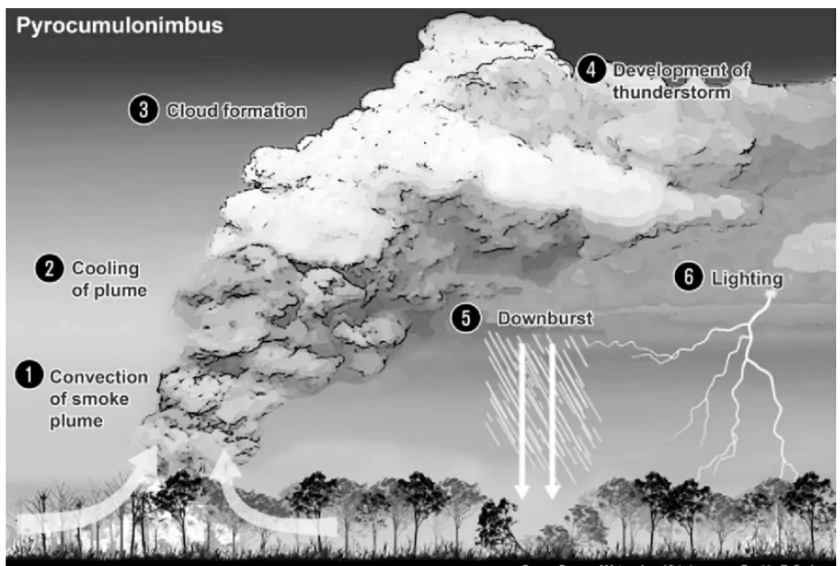The wildfires currently raging in the United States and Canada are so intense that they have created pyrocumulonimbus clouds.
- These pyrocumulonimbus clouds have the potential to spit out thunder and spark more fires.
About Pyrocumulonimbus Clouds
Pyrocumulonimbus clouds are thunder clouds created by intense heat from the Earth’s surface.
Enroll now for UPSC Online Course
- Occurrence: Not every wildfire leads to the creation of pyrocumulonimbus clouds. They occur only when there is an extremely hot wildfire or volcanic eruptions can also lead to the formation of pyrocumulonimbus clouds.
- Example: These clouds were formed during the Australian bushfires of 2019-2020 when temperatures crossed 800 degrees Celsius.
- Formation: The intense heat from the fire warms the surrounding air which moves upward into the atmosphere. As this hot and very buoyant air carrying water vapour, smoke, and ash rises, it expands and cools down.
 Pyrocumulus cloud: Once the hot air carrying water vapour, smoke, and ash is cool enough, water vapour condenses on ash, forming a grey or brown cloud. At this stage, the cloud is known as a pyrocumulus cloud, also known as ‘fire cloud’.
Pyrocumulus cloud: Once the hot air carrying water vapour, smoke, and ash is cool enough, water vapour condenses on ash, forming a grey or brown cloud. At this stage, the cloud is known as a pyrocumulus cloud, also known as ‘fire cloud’. - Pyrocumulonimbus Cloud: If there is sufficient water vapour available and the upward movement of hot air intensifies, pyrocumulus clouds can evolve into a pyrocumulonimbus cloud.
- These clouds can reach heights of 50,000 feet and generate their own systems of thunderstorms.
- Impact: Although pyrocumulonimbus clouds can produce lighting, they do not generate much rain. As a result, they can spark new wildfires many kilometres away from the main blaze.
- These clouds can also trigger strong winds that can make the spread of the wildfire faster and unpredictable.
Why are Pyrocumulonimbus Cloud events occurring more often?
The development of Pyrocumulonimbus Clouds has become more frequent in recent years.
- Rise in Occurrence: Before 2023, 102 pyrocumulonimbus were recorded globally in a single year on average — 50 of them were seen in Canada. However, during last year’s extreme wildfire season, 140 pyrocumulonimbus clouds were recorded in Canada alone.
- Impact of Climate Change: The exact reason remains unclear as unlike in the case of other extreme weather events. Scientists, however, believe that climate change could have a role to play in the increase of their frequency.
- Studies have shown that with temperatures soaring across the world, wildfires are becoming more common and intense. This could be spiking the occurrence of pyrocumulonimbus clouds.
Check Out UPSC CSE Books From PW Store
![]() 8 Aug 2024
8 Aug 2024
 Pyrocumulus cloud: Once the hot air carrying water vapour, smoke, and ash is cool enough, water vapour condenses on ash, forming a grey or brown cloud. At this stage, the cloud is known as a pyrocumulus cloud, also known as ‘fire cloud’.
Pyrocumulus cloud: Once the hot air carrying water vapour, smoke, and ash is cool enough, water vapour condenses on ash, forming a grey or brown cloud. At this stage, the cloud is known as a pyrocumulus cloud, also known as ‘fire cloud’. 